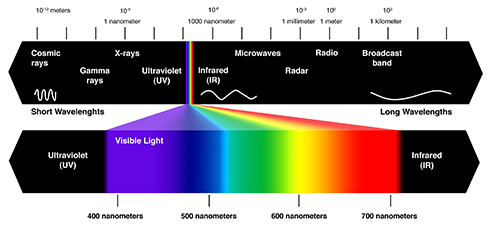Do We Not See Every Color?
January 19, 2021
You can see all the colors, red, orange, yellow, green, blue, purple. Right? Not quite.
In the color spectrum, there are areas beyond red and purple called infrared and ultraviolet. These colors are not visible to the human eye. But don’t feel bad; the only animals that see both infrared and ultraviolet are goldfish, believe it or not! But some animals can see just ultraviolet, like some insects or bees and butterflies. On the other end of the spectrum, the animals that can see infrared are a group of snakes called pit vipers.
Infrared can be detected to humans as heat. Infrared light changes the channel on your TV. Infrared light is divided into three sections: near, mid, and far infrared. Infrared light is like looking through a thermal camera. In 1800, William Herschel conducted an experiment measuring the difference in temperature between the colors in the visible spectrum. He placed thermometers within each color of the visible spectrum. The results showed an increase in temperature from blue to red. When he noticed an even warmer temperature measurement just beyond the red end of the visible spectrum, Herschel had discovered infrared light.
We can see some infrared light as heat. Some objects are so hot that they emit visible light such as fire. Other objects, such as humans, are not as hot and only emit infrared waves. We can “see” infrared light with special tools, like night vision goggles or infrared cameras.
Many objects in the universe are too cool or faint to be detected by visible light but can be detected in the infrared spectrum. Scientists are continuing to unlock the mysteries of the universe such as planets, stars, and nebulae, and many more by studying the way that infrared waves emit.
Infrared wavelengths are longer than normal light so they can see through clouds of gas and dust in space. The James Webb Space Telescope (JWST) has three infrared instruments to help study the origins of the universe and the formation of galaxies, stars, and planets.
Ultraviolet light is on the other end of the spectrum with shorter wavelengths than normal light. As ultraviolet (UV) light is invisible to the human eye, some insects, such as bumble bees, can see them. This is similar to how dogs can how a whistle just outside the hearing range of humans.
The sun is a source of the full spectrum of UV radiation, which is divided into UV-A, UV-B, and UV-C. UV-C rays are the most harmful and are almost completely absorbed by our atmosphere. UV-B rays are the harmful rays that cause sunburn. UV-B exposure increases the risk of DNA and other cellular damage. Luckly, 95% of UV-B rays are absorbed by the ozone layer in the Earth’s atmosphere.  In 1801, Johann Ritter conducted an experiment to investigate the existence of energy beyond the violet end of the visible spectrum. Knowing that photographic paper would turn black more rapidly in blue light than in red light, he exposed the paper to light beyond violet. Sure enough, the paper turned black, proving the existence of ultraviolet light.
In 1801, Johann Ritter conducted an experiment to investigate the existence of energy beyond the violet end of the visible spectrum. Knowing that photographic paper would turn black more rapidly in blue light than in red light, he exposed the paper to light beyond violet. Sure enough, the paper turned black, proving the existence of ultraviolet light.
Beyond the ends of the visible spectrum there are ultraviolet and infrared light. Infrared light can
not be seen to humans but can be felt as heat. Ultraviolet light can be very dangerous to your health as it causes a number of changes in the cells, tissue, and blood vessels on the skin.
But, infrared and ultraviolet light help us better understand the universe, as we can see things that we never could before. We now know how stars and planets are created, and that there are other galaxies out there.